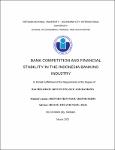| dc.description.abstract | Banking stability is vital to the economy. A few high-risk institutions failing might
affect the entire system. This study aims to better understand competition and financial stability in
developing economies. This study, unlike others, evaluates how competition has affected the
financial health of 24 Indonesian Stock Exchange (IDX) banks from 2009 to 2018. This study uses
the skewed competitiveness measure Herfindahl-Hirschmann measure (HHI). The NPL Ratio and
Z-Scores also indicate bank risk-taking. A dynamic panel specification examines competition's
effect on macroeconomic and bank-level factors such size, concentration, loan-to-assets ratio,
current ratio, capitalization, regulation, and profitability. The two-stage Generalized Method of
Moments (GMM) estimation approach produces empirical data. This study reveals that Indonesia's
banking sector becomes more competitive, bank charters lose value, and people take more risks.
These increased risks threaten financial stability. This strongly supports Indonesian banking's
competition-fragility theory. The research emphasizes the need to assess how competition may
affect emerging countries' financial stability and educate policymakers and regulators on banking
industry management and risk reduction. | en_US |


